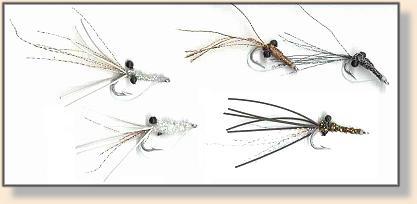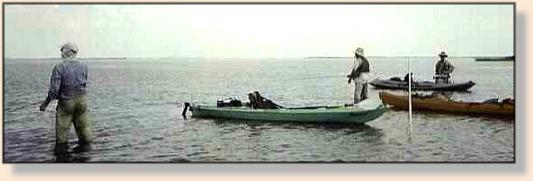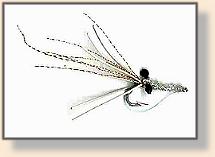|
Last month I got to find out how far it is up current, up wind, and over
the wake of shrimpers. The last part was scary. It was also the demise
of a Redstart 9X 9 flyrod. Not mine but it did belong to a good friend,
a pastor from North Texas.
There were two of us to start on Saturday afternoon from the "House of Boats"
just south of Rockport. We launched from the west end of the parking lot at a
'little beach' area. There was not a dock or breakwater here. Ever try to get
in a Kayak from a dock or in deep water? It takes a lot of practice to get it right.
While I am talking about Kayaks let me fill you in on some new developments.
The kayak of lore is just that. LORE. Compared to the ultra-light super strong Yaks
of today. They are more stable, faster, easier to paddle than you would think.
I had a Cobra Tandem this trip. I had been using a Cobra Explorer single
sit-on-top. Now a 'Sit-on-top" is just that, you sit on top of the hull, not inside it.
The new yaks are formed from a plastic that they form in molds, forming seats
and foot-rest right in the top of the hull. There is dry storage inside the hull. I
could keep my extra rod in the tandem's storage locker. With a sit-on-top you
can get in and out easily There are several different kayaks made today; no
make that many, many makers and styles of kayaks on the market today.
Check out oceankayak or on the West
Coast try actionwatersports
there are many sites on kayaks from the Sport boats that jump the rapids, (the
Olympic type) to the ocean travelers. I could not cover them in ten articles.
The Tandem on this trip was a 12-½ foot that would carry 600 lb. I spent time in
it alone and also with my fishing partner for the weekend, Steven Johncock from
Ft. Worth, it worked well both ways. I would not recommend it for rough sea
but in calm water I could stand up and fly fish.
Back to the story about the Shrimpers wake. The Pastor was in a small, single,
sit-inside yak that was only about 8-ft. long. When he hit the 6-ft. wake of an
outward bound 50 foot Shrimper he sort of rode high on the first then stuck into
he next wave. The shock was so hard that his fly rod, riding in the rod holder
was flipped out. I will say, he was somewhat lucky that it was on the way home.
I still think it was the bananas that caused the rod to jump out. As you know,
bananas on a fishing boat are very bad luck. Old seafarers tale. I had warned
him about them just before we started back to the launch area. We had kind
of met at the cut and enjoyed fishing together. Here is how it went.
Ron and I had left the dock about 4 AM . Texas (we call him "T"), followed a
little later and the Pastor was last to get there in his little yak.

The fishing was great at the cut just below the "House of Boats" about ¾ to 1 mile
down the Intercoastal Waterway. We were standing on a shallow sand bar casting
across the channel where the 'cut' comes through the spoil bar on Eastes Flats.
I was using my 9 ½ ft. 9 weight with a Clouser styled fly or a red Shrimple. This
is a fly Capt. Barry Evans ties just for saltwater. It is a great pattern with either
plastic or lead barbell eyes.
We keep in touch with the little FSR radios, that way we are not alone on the water.
Here we stood taking trout, and ladyfish or skipjack as some call them. After about
two hours of steady fighting trout we chose to try the flat. The wind was up and
made the drift a little fast. Like about 8 miles per hour. The weeds were the other
problem you would have to clean them every cast. It did not take long to tire us
out. We were headed back when the Shrimper came down the intercoastal.
(NOTE: Do wear a life jacket and strap your gear down when in the
waterway.) He was throwing a wake behind him 6 ft high. When he saw the
little boats, he did his best to lessen the wave. The Pastors little kayak was just
too short to span the wave. Water flew and then up popped the yak. Just a little
wet. It was not until we got to the launch area that he noticed behind him the
empty rod holder.
That morning we all (the Ft. Worth Fly Fishers outing group) put in at the "Crabman"
on the causeway. Here we found trout, redfish and mullet everywhere. They had
the water mudded up which can be good and bad. Makes it hard for the fish to see
you, but I was chasing a lot of mullet, until I found out how to tell the difference.
Forked tail or jumping fish, let them be. Waking fish or squaretails, cast ahead
of them.
The best place turned out to be a deeper trench that formed from the tidal action.
This small "gut" as Capt. Barry called it was a natural feeding place. All the water
flowing from the grass flats would funnel right into this 25 ft. wide ditch. Being
over 150 foot long it gave all of the fly casters a place to cast. Not long casts,
just faster retrieves. So if you could cast farther, then you could cover more area.
Not sight casting, just 'let it rip casting.'
Lunch time took some of us back to Hunt's Castle where we were staying, right
on the water. Time for a shower and some more cool water. NOTE: Take
three time as much water as you would any other time. Texas sun and saltwater
will keep you drinking all the time. After lunch Ron Newton and I started
down the Intercoastal Waterway to find a cut he had fished before. T and the Pastor
found us via radio on their way back to the motel. They just pulled
up and dropped off their yaks to join in the fun.
Sunday Morning we found the fish. I mean the whole Ft. Worth Fly Fishers
club members that came were into fish: Redfish, Trout, and Black Drum. Now
if I tell you where, I might get left behind next time. The fact was in words
of H. Greeley "Go West young man." We all had breakfast at Kline's and
then caravaned to the launch site.
The water was not over 2 foot deep and flat as you could ask for. Steven and
I headed off to the right. Some went left, others straight ahead. Just about
200 yards down the bay I saw the birds working close to the surface. To sound
like an old salt and quote a seafarer, "The birds, the birds will lead the way."
Soon we were standing in water just above our knees, having staked out the
kayaks. The Trout were chasing and feeding on anything that moved. We just
cast out as far as we could and stripped in fast. Wham! The ladyfish would
slam the flies. The next cast might be a seatrout of about 18 to 28 inches.
Just great fun fighting fish and laughing with fellow fly fisherman. Remember,
I said we were radio equipped. So all the club could take a shot at catching a fighter.

Steven wanted a big black drum or bull redfish, so we pulled up and paddled to
the northeast, searching for square tails or telltale "V's". We traveled about 3
miles. In this distance we saw no less than 75 fish. They just would not eat our offerings.
We did pick up a few trout but the reds were moving and not tailing.
The radio kept us informed of the luck of the rest. It sounded like some were
taking red fish almost every cast. Like us, many found the reds not feeding.
All but Capt. Barry. He found a spot where he could stand and wait for the reds
to come to him and he was ready. Barry uses a 9 ft. 8 wt., Pac-Bay custom-made
rod with a WF8-F line. Sharp-eyed, he looks like a heron poised to strike. Sending
out the "shoefly popper" another of his great flies, he waits for the fish to set
themselves. Then he puts the rod to work subduing the fish fast and easily to
release it to fight again. He had called his fishing partner Bill Crowe on the radio
and soon both had redfish on the end of their fly lines. Bill paddles a Scupper
Pro, the most popular fly fishing kayak. Barry uses a "Ride" that he has outfitted
with almost everything, compass, GPS and rod holders.

Lunch time and more cool water. Tying time to replace the flies lost. Shrimples,
with plastic eyes & weedguards. Shoeflies in browns. Then off to Goose Island.
Here T, Steven and I met a local fisherman who was a past member of the FWFF
club. He said that across the San Antonio Bay there had been some good redfishing.
We picked out a landmark and headed out. T soon took the lead in his Prizm, with
Steven in the back. We were fighting the following sea as we paddled about 3 or
4 miles to the far shore. The water was muddy, the bottom was soft. Both did
not lend to flyfishing. After giving it a good try we set off on the return trip. It
took about 55 minutes to cross the bay.
"WHAT IS THAT?" Steven asked from the front seat, pointing to a pair of large
black fins coming our way. They were Porpoise. Three or four of them made a
pass right alongside of the Kayak. They were about 8 to 10 feet long and they
were playfully swimming along. "That was a real treat," stated Steven.
We soon found the bottom again and I hooked the yak to my belt and started
wading along the shore or about 100 yards off of it. NOTE: When wading
on the Texas flats do the shuffle to scare off the stingrays. They were everywhere.
Here we spooked a few nice reds and a black drum. I guess it was not for me
to catch a red this trip. I do not mind for I have taken them before and the trout
sure did keep me busy. All in all it was a great trip with good friends. What more
could I wish for?
Fly casting is as easy as flysoup. ~ Allen Crise
|





